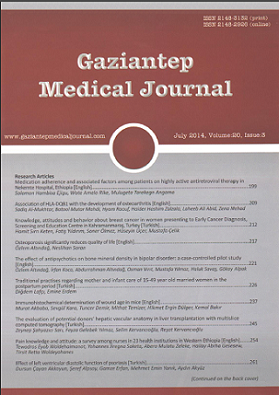Immunohistochemical determination of wound age in mice
Farelerde immunohistokimyasal metodlarla yara yaşı tespiti
DOI:
https://doi.org/10.5455/GMJ-30-156593Keywords:
Forensic pathology, immunohistochemistry, Ki-67 antigen, ubiquitinAbstract
Determination of wound age is one of the greatest challenges in autopsy cases. We have little knowledge on this issue despite a plethora of current studies. The purpose of this study was to shed light on wound age determination by studying the expression levels of ubiquitin and Ki-67 through immunohistochemical methods. A total of 45 (Balb/c) 6-8 week-old male mice, weighing 25-30 grams were divided into nine groups including five mice in each group. After general anesthesia, a 1.5 cm full-thickness incision was made on the dorsal skin using a scalpel. At 1, 3, 6, 12, and 24 hours and 5, 7, and 14 days, a total of 42 mice were sacrificed by cervical dislocation. An area of 1 cm surrounding the wound was excised. One mouse died in each of the Groups 6, 7, and 8, leaving 42 mice to complete the study. The mean number of fibroblasts with positive Ki-67 staining at the wound edge was significantly higher in Groups 4, 5 and 6. Groups 5 and 6 showed a statistically significant percentage of Ki-67 positive staining basal cells. Groups 7 and 8 exhibited similar features with the control group. Ubiquitin-positive fibroblast cells in Groups 1 to 4 showed similar features with the control group and the number of ubiquitin-positive fibroblast cells was statistically significant in Groups 5, 6 and 7. As a marker, ubiquitin may be useful in determining whether the wound age is older than 1 day and may be used for wounds 1 to 7 days old. We suggest that the Ki-67 marker may assist in the determination of the age of 1 to 5-day-old wounds by using immunohistochemical methods.
Metrics
References
Witte MB, Barbul A. General principles of wound healing. Surg Clin North Am 1997;77(3):509-128.
Broughton G 2nd, Janis JE, Attinger CE. The basic science of wound healing. Plast Reconstr Surg. 2006;117(7 Suppl):12S34S.
Grellner W, Madea B. Demands on scientific studies: vitality of wounds and wound age estimation. Forensic Sci Int 2007;165(2-3):150-4.
Çetin G. Yaralar, Adli Tıp ers Kitabı. Cilt 1, 1. Baskı. Eds Soysal , Çakalır C, I stanbul niversitesi Cerrahpaşa Tıp Faku ltesi Yayınları, o.4165/224, I stanbul 1999;475-523.
Gerdes J, Schwab U, Lemke H, Stein H. Production of a mouse monoclonal antibody reactive with a human nuclear antigen associated with cell proliferation. Int J Cancer 1983;31(1):13-20.
Scholzen T, Gerdes J. The Ki-67 protein: from the known and the unknown. J Cell Physiol 2000;182(3):311-22.
Ikeda G, Isaji S, Chandara B, Watanabe M, Kawarada Y. Prognostic significance of biologic factors in squamous cell carcinoma of the esophagus. Cancer 1999;86(8):1396-405.
Chau V, Tobias JW, Bachmair A, Marriot D, Ecker DJ, Gonda DK et al. A multiubiquitin chain is confined to specific lysine in a targeted short-lived protein. Science 1989;243(4898):1576-83.
Goldberg AL, Stein R, Adams J. New insights into proteasome function: from Archaebacteria to drug development. Chem Biol 1995;2(8):503-8.
King RW, Deshaies RJ, Peters JM Kirschner MW. How proteolysis drives the cell cycle. Science 1996;274(5293):1652-9.
Vlachostergios PJ, Voutsadakis IA, Papandreou CN. The ubiquitin-proteasome system in glioma cell cycle control. Cell Div 2012;7(1):18.
Kondo T, Tanaka J, Ishida Y, Mori R, Takayasu T, Ohshima T. Ubiquitin expression in skin wounds and its application to forensic wound age determination. Int J Legal Med 2002;116(5):267-72.
Pakiş I, Kaya EA. Adli Tıp uygulamalarında yara yaşı ve canlılık bulgularının değerlendirilmesi. Adli Tıp ergisi 2011;25(2):137-52.
Ohshima T. Forensic wound examination. Forensic Sci Int 2000;113(1-3):153-64.
Grellner W. Time-dependent immunohistochemical detection of proinflammatory cytokines (IL-1ß, IL-6, TNFin human skin wounds. Forensic Sci Int 2002;130(2-3):90-6.
Gillitzer R, Goebeler M. Chemokines in cutaneous wound healing. J Leukoc Biol 2001;69(4):513-21.
ressler J, Bachmann L, Koch, Müller E. Estimation of wound age and VCAM-1 in human skin. Int J Legal Med 1999;112(3):159-62.
Dressler J, Bachmann L, Kasper M, Hauck JG, Müller E. Time dependence of the expression of ICAM-1 (CD 54) in human skin wounds. Int J Legal Med 1997;110(6): 299-304.
Hayashi T. Ishida Y. Kimura A Takayasu T, Eisenmenger W, Kondo T. Forensic application of VEGF expression to skin wound age determination. Int J Legal Med 2004;118(6):320- 5.
Betz P, erlich A, Wilske J Tübel J, Penning R, Eisenmenger W. The time-dependent localization of Ki67 antigen-positive cells in human skin wounds. Int J Legal Med 1993;106(1):35-40.
Quan L, Zhu BL, Oritani S, Ishida K Fujita MQ, Maeda H. Intranuclear ubiquitin immunoreactivity in the pigmented neurons of the substantia nigra in fire fatalities. Int J Legal Med 2001;114(6):310-5.
Ishikawa T, Zhu BL, Li DR, Zhao D, Michiue T, Maeda H. Immunohistochemical investigation of ubiquitin and myoglobin in the kidney in medicolegal autopsy cases. Forensic Sci Int 2007;171(2-3):136-41.
Guler H, Aktas EO, Karali H, Aktaş S. The importance of tenascin and ubiquitin in estimation of wound age. Am J Forensic Med Pathol 2011;32(1):83-9.
Downloads
Published
How to Cite
Issue
Section
License
Copyright (c) 2023 European Journal of Therapeutics

This work is licensed under a Creative Commons Attribution-NonCommercial 4.0 International License.
The content of this journal is licensed under a Creative Commons Attribution-NonCommercial 4.0 International License.


















